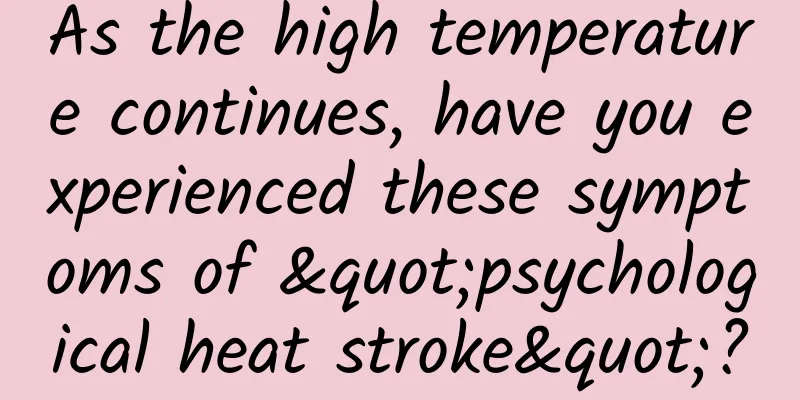As the high temperature continues, have you experienced these symptoms of "psychological heat stroke"?

|
With the start of the "high temperature mode" this summer, the temperature in various places has "set new highs", and temperatures of 40 degrees are not uncommon. Words such as "heatstroke" and "heat stroke" have once again entered the public eye. Severe heat stroke can lead to multiple organ failure. Once it occurs, the mortality rate is extremely high, which has attracted widespread attention. But do you know that in addition to physical damage, another harm caused by high temperatures is quietly affecting people's health, that is "psychological heat stroke." Part 1 What is psychological heat stroke? Psychological heatstroke refers to the emotional, cognitive and behavioral abnormalities that people may experience during the hot summer, which is medically known as "summer affective disorder" and is mainly manifested by irritability, disordered thinking, irritability and uncontrolled behavior. Psychological symptoms of heat stroke (Photo source: Jining News Network) Psychological heat stroke often occurs in summer and hot weather, especially heat wave days, which are days when the temperature exceeds 35 degrees Celsius for three consecutive days. If psychological heatstroke is not intervened, it will have a significant impact on the individual's mental and physical health. The "psychological heat stroke" caused by high temperatures has been confirmed by many researchers. Many experiments have shown that on hot days, the rate of visits to psychological emergency departments will generally increase (including substance use disorders, anxiety, stress-related and somatoform disorders, affective disorders, etc., see Figure 2). Relationship between temperature and psychiatric emergency department visits (Image source: Nori-Sarma, A.et al., 2021) High temperatures are associated with interpersonal and intergroup aggression, violent suicidal behavior, and the emergence of emotional problems such as depression, anxiety, and anger. Researchers have found that aggressive and suicidal behavior fluctuate seasonally, with more aggressive incidents in summer, such as domestic violence, social unrest, and interpersonal conflicts, than in other seasons of the year. Within a certain range, there is a positive correlation between increased temperature and suicide risk (see Figure 3). When the temperature exceeds 18°C, the relative risk of suicidal behavior increases by about 3.8% for every 1°C increase. In addition, the study also found that the number of hospitalizations for bipolar disorder, depression, and anxiety was positively correlated with the temperature of the day. In hot weather, people generally report more severe depression and anxiety than in cold weather. Average temperature and suicide risk (Image source: Page, LA, Hajat, S., & Kovats, RS, 2007) So, what causes "psychological heatstroke"? Part 2 What are the factors that cause "psychological heat stroke"? Scientists try to explain the "violent tendency" under high temperatures from different angles. First, from a biological mechanism perspective, neurotransmitters such as serotonin and dopamine vary with the seasons and are negatively correlated with impulsivity, aggression, etc. (Gao et al., 2019). Hot weather can lead to a decrease in serotonin and dopamine, which will not only increase a person's aggression and impulsivity, but also reduce their inhibitory function, leading to uncontrolled behavior (see Figure 4). The Role of Dopamine, Serotonin, and Norepinephrine (Image source: thespinalcentre.com.au) In addition to neurotransmitters, neuroinflammation caused by high temperature may also play a role. Studies have shown that rats exposed to high temperature environments will have significant neuroinflammatory responses and neuronal cell death in the hippocampus, which may have long-term effects on attention, memory or personality. These intrinsic changes in the brain may reduce people's awareness of their environment and their ability to adapt , which in turn may make them more susceptible to exposure to and effects of heat. This could also explain why those with psychiatric or neurological conditions, such as Alzheimer's, may be more vulnerable to the effects of high temperatures. In addition, some researchers have proposed the brown adipose tissue theory (He Bin, Wang Bingwei, Zheng Ruimao, 2016). Brown adipose tissue is one of the main sources of heat production in mammals and plays an important role in maintaining the homeostasis of animals (see Figure 5). High temperatures will over-activate this type of tissue and damage the body's heat tolerance. This damage will change the neural activity of the brain area projected by brown adipose tissue, causing people to have abnormal emotions or behaviors, affecting individual mental health. White fat vs brown fat (Image source: Deshmukh, A Set al., 2019) Secondly, from a sociological perspective, people are more likely to consume excessive amounts of alcohol on hot days (Thompson, R. et al., 2018), such as drinking ice beer to cool off. Individuals are also prone to anxiety and stress in high-temperature environments, and they feel that they cannot alleviate this high temperature, which further exacerbates negative emotions. Therefore, they tend to use substances such as alcohol to relieve stress, and alcohol has a significant disinhibition function, making individuals more likely to exhibit impulsive aggressive behavior. Drinking cold beer in summer (Photo source: veer photo gallery) Finally, from the perspective of cognitive psychology , the emergence of this type of violent tendency is inseparable from anger. According to Schacht-Singer's emotion theory, the generation of our emotions is related to the cognitive attribution of physiological reactions (see Figure 7). This theory can explain the well-known "suspension bridge effect". When we walk on a suspension bridge with another friend, our heart rate will accelerate due to tension and fear. However, if we attribute this heart rate reaction to "liking our friend", then we will really have the emotion of liking him/her, which will produce the "suspension bridge effect". Schacht-Singer theory of emotion (Image source: Introduction to Psychology, Liang Ningjian) So how does this theory explain the relationship between high temperatures and anger? When in a high temperature environment, individuals are prone to physiological reactions such as sweating, thirst, and fever. These physiological reactions are similar to those when we are angry. At this time, if we receive weak external signals, such as unintentional offensive behavior from others, we are likely to interpret the current physiological reaction as "anger" and generate anger or even "violent tendencies" . This is why we feel more irritated and angry in a hot environment. Of course, in addition to anger, depression, anxiety and other emotional problems are also factors that contribute to violent behavior. In fact, high temperatures do aggravate negative emotions such as depression and anxiety, but what are the specific reasons? In fact, there is an inverted U-shaped relationship between temperature and mental health (Mullins, JT, & White, C., 2019). When the temperature is very high, people go out less frequently, reducing the chance of exposure to high temperatures, and their mental health level will improve. This effect of temperature on mental health and emotional problems is often mediated by cognitive factors . Temperature can cause the body and brain temperature to rise, and directly lead to a decrease in cognitive function, coping ability or stress threshold through the influence of neurotransmitters. Therefore, people's ability to regulate emotions will decrease , leading to a series of negative emotions and emotional disorders. For older people or those with dementia, the damage can be even greater. Psychologists who hold the theory of health-maintaining behavior suggest that when high temperatures persist for days or weeks, an individual's physiological and behavioral adaptation strategies will be challenged, and previous methods of relieving stress may no longer be applicable. For example, outdoor exercise that helps maintain the body's physiological and mental health will be significantly reduced. There is evidence that temperature affects the amount of time spent outdoors (Brown, Barton, & Gladwell, 2013), which can make individuals’ adaptation and normal stress relief problematic, thereby making them more susceptible to emotional problems. Outdoor Activities (Photo source: veer photo gallery) From the perspective of sleep disruption caused by heat, there is evidence that sleep problems are associated with almost all psychiatric illnesses or disorders (i.e. dementia, affective disorders, addiction, schizophrenia, etc.) (Mullins, JT, & White, C., 2019). High nighttime temperatures significantly reduce sleep quality and duration (see Figure 3). Such sleep problems are directly related to increased irritability, depression, and negative emotions . This may explain why high daytime and nighttime temperatures during heat waves can lead to worsening mental health-related conditions. Relationship between nighttime temperature and sleep quality and duration (Image source: Mullins, JT, & White, C., 2019) Part 3 How to prevent psychological heat stroke? Based on the discussion of psychological heat stroke mechanisms and susceptible populations, we must make some useful prevention recommendations. Since high temperatures can have many adverse effects on human physiology, psychology, and behavior, and as global warming continues, this effect may become more important than the effects of other factors. So how can we reduce the psychological impact of high temperatures on us? 1. Appropriate attribution . Remember the previous discussion on emotional attribution? Once we attribute physiological reactions to the offensive behavior of others in the environment rather than the high temperature, individuals will be more likely to feel angry. Therefore, if individuals are able to clearly understand that temperature affects their emotions, they are more likely to attribute their reactions to hot weather rather than external events, and thus correct their emotions and behaviors. 2. Get enough sleep . A German study showed that the increased sleep brought by daylight saving time led to a reduction of nearly one-third in suicide attempts. This shows how important good sleep is to our emotional state. Maintaining a normal schedule and getting enough sleep is not only beneficial to physical health, but also strengthens our mental health. Maintain good sleep quality (Photo source: veer photo gallery) 3. Drink less . Conflicts and violent incidents caused by drinking are common in summer. To reduce such violent incidents, not only the participation of public security management is needed, but also people need to raise their awareness of the harm of drinking, reduce drinking as much as possible, keep themselves sober and restrained, and reduce the occurrence of violent incidents. 4. Work from home . In abnormally hot weather, such as heat waves with temperatures above 40 degrees, it is necessary to properly arrange work from home, give workers who work outdoors a holiday, and reduce commuting time in a hot and humid environment. References: [1] Yu Guoliang, Chen Tingting, & Zhao Fengqing. (2020). The impact of temperature and temperature change on mental health. Advances in Psychological Science, 28(8), 11. [2] He Bin, Wang Bingwei, Zheng Ruimao. (2016). Circadian regulation of thermogenesis in human brown adipose tissue. Progress in Physiological Sciences, 47(5), 390. [3] Brown, DK, Barton, JL, & Gladwell, VF (2013). Viewing nature scenes positively affects recovery of autonomic function following acute-mental stress. Environmental Science & Technology, 47(11), 5562–5569. doi: 10.1021/es305019p [4] Deshmukh, AS, Peijs, L., Beaudry, JL, Jespersen, NZ, Nielsen, CH, Ma, T., Brunner, AD, Larsen, TJ, Bayarri-Olmos, R., Prabhakar, BS, Helgstrand, C., Severinsen, M., Holst, B., Kjaer, A., Tang-Christensen, M., Sanfridson, A., Garred, P., Privé, GG, Pedersen, BK, Gerhart-Hines, Z., … Scheele, C. (2019). Proteomics-Based Comparative Mapping of the Secretomes of Human Brown and White Adipocytes Reveals EPDR1 as a Novel Batokine. Cell metabolism, 30(5), 963–975.e7. https://doi.org/10.1016/j.cmet.2019.10.001 [5] Gao, J., Cheng, Q., Duan, J., Xu, Z., Bai, L., Zhang, Y., ... Su, H. (2019). Ambient temperature, sunlight duration, and suicide: A systematic review and meta-analysis. Science of The Total Environment, 646, 1021–1029. doi: 10.1016/j.scitotenv.2018.07.098 [6] Liu, J., Varghese, BM, Hansen, A., Xiang, J., Zhang, Y., Dear, K., Gourley, M., Driscoll, T., Morgan, G., Capon, A., & Bi, P. (2021). Is there an association between hot weather and poor mental health outcomes? A systematic review and meta-analysis. Environment international, 153, 106533. https://doi.org/10.1016/j.envint.2021.106533 [7] Mullins, JT, & White, C. (2019). Temperature and mental health: Evidence from the spectrum of mental health outcomes. Journal of health economics, 68, 102240. https://doi.org/10.1016/j.jhealeco.2019.102240 [8] Nori-Sarma, A., Sun, S., Sun, Y., Spangler, KR, Oblath, R., Galea, S., Gradus, JL, & Wellenius, GA (2022). Association Between Ambient Heat and Risk of Emergency Department Visits for Mental Health Among US Adults, 2010 to 2019. JAMApsychiatry, 79(4),341-349.https://doi.org/10.1001/jamapsychiatry.2021.4369 [9] Page, LA, Hajat, S., & Kovats, RS (2007). Relationship between daily suicide counts and temperature in England and Wales. The British journal of psychiatry : the journal of mental science, 191, 106–112. https://doi.org/10.1192/bjp.bp.106.031948 [10] Thompson, R., Hornigold, R., Page, L., & Waite, T. (2018). Associations between high ambient temperatures and heat waves with mental health outcomes: a systematic review. Public health, 161, 171–191. https://doi.org/10.1016/j.puhe.2018.06.008 Produced by: Science Popularization China Author: Zhu Zhengqing (Institute of Psychology, Chinese Academy of Sciences) The article only represents the author's views and does not represent the position of China Science Expo This article was first published in China Science Expo (kepubolan) Please indicate the source of the public account when reprinting Please indicate the source of the reprint. Reprinting without authorization is prohibited. For reprint authorization, cooperation, and submission matters, please contact [email protected] |
<<: What makes me believe in light is not Ultraman, but quantum mechanics!
Recommend
New trends in ASO optimization in 2016!
The bell of 2016 has rung. Looking back on 2015, ...
Full process analysis of improving APP push conversion rate
An APP without message push function cannot be ca...
Judging from the sales of Double 11, the conclusion that the OTT industry is dying is absurd
In just 38 minutes, Tmall’s total sales reached t...
How do we do code review?
A few days ago, I read "Code Review: The Hop...
If you could put a "deadline" on a cell phone, the manufacturer would say: "Three years!"
If a time limit is set for the happy life between...
From "chopping rockets with chopsticks" to adjusting the water temperature in the shower, this knowledge is indispensable
At about 7:32 a.m. local time on October 13 (20:3...
3 ways to play, 4 key points, revealing the operation routine of the big wheel lottery event
The roulette wheel lottery is one of the activity...
Why do birds make different calls?
It is the season of birds singing, flowers bloomi...
Seven Paint's "Tiktok from Novice to Elite Practical Training Camp" takes you to master Tiktok account operations
SEVEN paint · 2022 TIKTOK practical training camp...
Different thermometers measure body temperature with a difference of 1 degree. Which one should I buy?
Science Fiction Network, December 22, recently, n...
The 9 most effective free fission customer acquisition, retention and monetization methods in 2020!
Affected by the epidemic, many companies have tra...
Foshan shared power bank mini program has customized functions. How much does the shared power bank mini program cost?
With the advent of the 5G era, the network speed o...
Is life in space full of dangers? What changes do astronauts experience in their bodies while in space?
The human body is an extremely complex and sophis...
Copying 100 companies? What are Xiaomi's limitations?
Two and a half years ago, I wrote an article titl...
Wearable health devices: The future looks bright
Just by wearing a bracelet, you can know how many...









